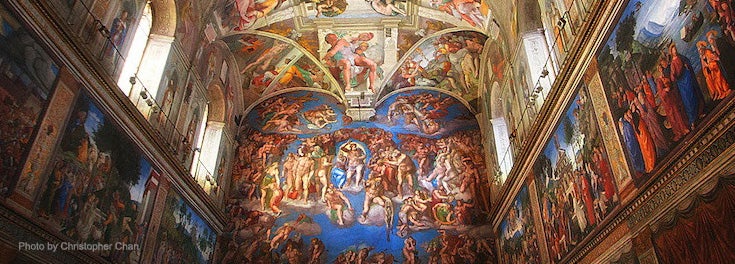Pope Benedict XVI stunned the world with his resignation announcement last month. Speculation, wonder, and even a bit of anxiety have filled the globe (and the media) ever since, as observers wait to learn who will be the next successor to Saint Peter. At URI, History Professor Joelle Rollo-Koster and Philosophy Professor Fritz Wenisch put this historic time into modern-day context.
Now begins the worldwide media speculation about who will succeed Benedict…. Historically, the pope was not only a religious leader but also a head of state as important as, say, the chancellor of Germany. -Professor Fritz Wenisch
Benedict’s resignation has filled us with wonder because the first time – and last time – a legitimately elected pope resigned willingly was more than 700 years ago. In fact, some observers may have even forgotten that a pope is allowed to resign at all. In an editorial to the Providence Journal, Professor Rollo-Koster, URI’s own Vatican/papal historian, explained how the first papal resignation unfolded under Pope Celestine V and paved the way for Benedict to do the same.
Celestine wasn’t supposed to be pope. According to Rollo-Koster, he unwittingly earned himself the papal election on July 5, 1294 after writing a letter to the cardinals (the group of senior officials in the Catholic Church charged with electing a new pope when the seat is vacant) castigating them for taking more than two years to elect a successor to Pope Nicholas IV. Pope Celestine was ill equipped for the office and wound up being controlled by the King of Naples. Almost immediately, he contemplated resignation. But “for a good part of the Middle Ages, and based on scripture, the prospect of an abdication had always been considered irrelevant. 1 Cor 7: 20 states, ‘Each person should remain in the situation they were in when God called them,’ making abdication impossible,” Rollo-Koster wrote.
In today’s vernacular, one could say that Celestine found a “loophole.” “Pope Innocent III in the early 13th century had established that a bishop could resign in sickness, physical or mental impediment; because of criminal activities; if he was disliked, obstinate, or irritated people; or if he chose to enter cloistered life,” Rollo-Koster said. The pope is, essentially, a bishop. And on December 10, 1294, just six months after his election, “Pope Celestine abdicated in front of his cardinals, claiming illness, incompetence, and his wish to return to his eremitic life.”
Once the news of Benedict’s resignation sunk in, worldwide media speculation about who would become his successor as the leader of the Roman Catholic Church began. Professor Wenisch, an expert and commentator on Catholic doctrine and religious issues, says that global interest is rooted in history. “Historically, the pope was not only a religious leader but also a head of state as important as, say, the chancellor of Germany. In earlier centuries, most of Europe was Roman Catholic. There was a sense of allegiance among national leaders to the pope, so who the pope was had significant ramifications on domestic policy worldwide.” Wenisch said the pope influence not only in religious issues, but also political ones, is most probably the root of the longstanding historical tradition of extreme violence during papal elections.
In an editorial to the New York Times, Rollo-Koster explains: “For the first 1,000 years, the nomination of popes was at the mercy of consensus among the clergy, the people of Rome, the Roman aristocracy, and various rulers who expected to manipulate the nomination for their own purposes. ‘Consensus’ was often obtained after mobs ransacked and pillaged ecclesiastical property, especially the Lateran Palace where popes lived.” According to Rollo-Koster, two key efforts to end electoral violence in the 12th and 13th centuries established practices that still exist in today’s papal election process. First, an 1179 mandate made all cardinal’s votes equal and required only a majority of two-thirds of the cardinal’s vote for election of the next pope. The effort failed to quell the violence, but the two-thirds majority rule still stands. Second, in 1274, cardinals were “enclosed and controlled with key (cum clave hence ‘conclave’) to deliberate ‘safely’ in tight quarters with little privacy and external contact.”
On March 12, the 115 cardinals under the age of 80 went into conclave at the Vatican to begin the process of electing the next pope. Wenisch says that while he’s still the head of Vatican City, the pope’s role today lies more in his role as the authority figure for the over 1.8 billion Catholics and as a moral leader for many religious and secular groups around the world. Sexual misconduct within the Catholic Church, abortion, and same-sex marriage are surely among the big issues of moral and religious significance on the minds of the global population – Catholic and otherwise – Wenisch said.
Rollo-Koster says that papal election history teaches us “that it is difficult to disengage religion from worldly practices; that the wealth of the Church has always attracted envy; and maybe, most of all, that people want to participate in and not be shut off from power.” Today’s media attention to the matter suggests little has changed. Despite the intense speculation – would he be the first African pope? The first Jesuit pope? The first North American pope? – the secrecy of the process makes it impossible to truly know who is considered during the conclave. Wenisch tells us “there is always a list of people bantered about by the media and pundits, but the selection often turns out to be someone unexpected.” Either way, he believes Benedict’s resignation, while history making, is a good thing. “This resignation will make it easier for others to resign going forward, and isn’t better for this important father figure to have that opportunity before he becomes too ill to serve his community?”
See Professor Joelle Rollo-Koster’s recent appearance on the local NBC affiliate following the announcement of Pope Francis I.
Photo credit: Christopher Chan

